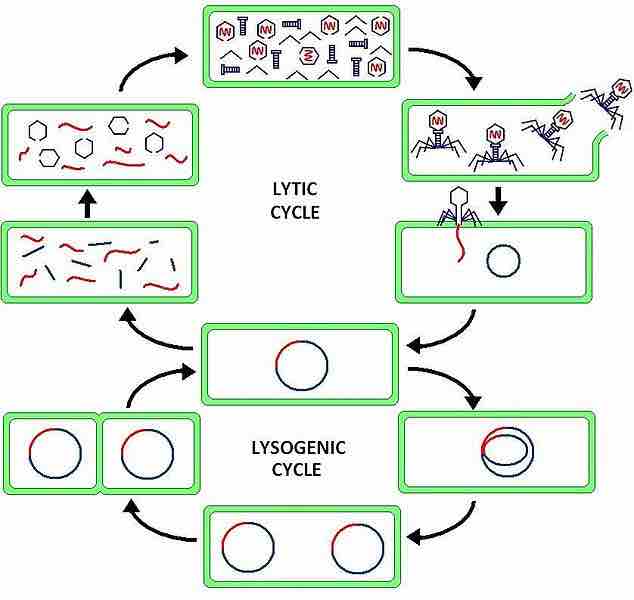Virulence is the degree of pathogenicity within a group or species of parasites as indicated by case fatality rates and/or the ability of the organism to invade the tissues of the host. The pathogenicity of an organism is determined by its virulence factors. Virus virulence factors determine whether an infection will occur and how severe the resulting viral disease symptoms are. Viruses often require receptor proteins on host cells to which they specifically bind. Typically, these host cell proteins are endocytosed and the bound virus then enters the host cell. Virulent viruses such as HIV, which causes AIDS, have mechanisms for evading host defenses.
Some viral virulence factors confer ability to replicate during the defensive inflammation responses of the host such as during virus-induced fever. Many viruses can exist inside a host for long periods during which little damage is done. Extremely virulent strains can eventually evolve by mutation and natural selection within the virus population inside a host. The term "neurovirulent" is used for viruses such as rabies and herpes simplex which can invade the nervous system and cause disease there.
Model organisms of virulent viruses that have been extensively studied include virus T4 and other T-even bacteriophages which infect Escherichia coli and a number of related Bacteria.
The lytic cycle is one of the two cycles of viral reproduction, the other being the lysogenic cycle . The lytic cycle is typically considered the main method of viral replication, since it results in the destruction of the infected cell. A key difference between the lytic and lysogenic phage cycles is that in the lytic phage, the viral DNA exists as a separate molecule within the bacterial cell, and replicates separately from the host bacterial DNA. The location of viral DNA in the lysogenic phage cycle is within the host DNA, therefore in both cases the virus/phage replicates using the host DNA machinery, but in the lytic phage cycle, the phage is a free floating separate molecule to the host DNA.

Cycles of viral reproduction
Comparison of the bacteriophage lysogenic and lytic cycles.
The lytic cycle is a six-stage cycle. In the first stage, called "penetration," the virus injects its own nucleic acids into a host cell. Then the viral acids form a circle in the center of the cell. The cell then mistakenly copies the viral acids instead of its own nucleic acids. Then the viral DNA organize themselves as viruses inside the cell. When the number of viruses inside becomes too much for the cell to hold, the membrane splits and the viruses are free to infect other cells. Some viruses escape the host cell without bursting the cell membrane; instead, they bud off from it by taking a portion of the membrane with them. Because it otherwise is characteristic of the lytic cycle in other steps, it still belongs to this category, although it is sometimes named the Productive Cycle. HIV, influenza and other viruses that infect eukaryotic organisms generally use this method.
T-4 bacteriophage is a bacteriophage that infects E. coli bacteria. Its double-stranded DNA genome is about 169 kbp long and is held in an icosahedral head, also known as a capsid. T4 is a relatively large phage, at approximately 90 nm wide and 200 nm long (most phages range from 25 to 200 nm in length). Its tail fibres allow attachment to a host cell, and the T4's tail is hollow so that it can pass its nucleic acid to the cell it is infecting during attachment. T4 is capable of undergoing only a lytic lifecycle and not the lysogenic lifecycle.
The T4 Phage initiates an E. coli infection by recognizing cell surface receptors of the host with its long tail fibers (LTF). A recognition signal is sent through the LTFs to the baseplate. This unravels the short tail fibers (STF) that bind irreversibly to the E. coli cell surface. The baseplate changes conformation and the tail sheath contracts causing GP5 at the end of the tail tube to puncture the outer membrane of the cell. The lysozyme domain of GP5 is activated and degrades the periplasmic peptidoglycan layer. The remaining part of the membrane is degraded and then DNA from the head of the phage can travel through the tail tube and enter the E. coli.
The lytic lifecycle (from entering a bacterium to its destruction) takes approximately 30 minutes (at 37 °C) and consists of:
- Adsorption and penetration (starting immediately)
- Arrest of host gene expression (starting immediately)
- Enzyme synthesis (starting after 5 minutes)
- DNA replication (starting after 10 minutes)
- Formation of new virus particles (starting after 12 minutes)
After the life cycle is complete, the host cell bursts open and ejects the newly built viruses into the environment, destroying the host cell. T4 has a burst size of approximately 100-150 viral particles per infected host. Complementation, deletion, and recombination tests can be used to map out the rII gene locus by using T4. These bacteriophage infect a host cell with their information and then blow up the host cell, thereby propagating themselves.
The T4 phage has some unique features, including:
- Eukaryote-like introns
- High speed DNA copying mechanism, with only 1 error in 300 copies
- Special DNA repair mechanisms
- It infects E. coli O157:H7